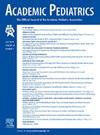Youth Survivors of Human Trafficking: On Improving Health Care Access and Treatment
IF 3
3区 医学
Q1 PEDIATRICS
引用次数: 0
Abstract
Objective
Human trafficking (HT) is a public health issue, with adolescents disproportionately at risk for reasons spanning multiple biopsychosocial domains. We explored youth HT survivors’ health care barriers, experiences, and needs.
Methods
In this qualitative multimethods study, 24 participants (≤26 years old) with HT experience receiving services from nonprofit organizations in San Diego, California completed an electronic survey and were invited to participate in online interviews. Thematic analysis for interview responses was performed using constant comparative methodology. Authors created codes and connections between codes and refined findings by discussion.
Results
All participants endorsed labor trafficking, 96% endorsed sex trafficking and 46% reported seeing a health care professional (HCP) while exploited. Nine survey respondents completed follow-up interviews: 100% endorsed labor and sex trafficking and 44% seeing an HCP. Interview participants’ barriers to presenting to health care and receiving needed help were categorized into patient-focused—lack of awareness of exploitation and medical needs, emotional bonds to the trafficker, and misperceptions about their ability to obtain care; versus health care system (HCS)-focused—negative experiences and need for consistency with HCPs, and desire for targeted resources and effective care.
Conclusions
Barriers to health care for trafficked youth included factors the HCS could change versus those that could be reduced with universal patient education. Participants named lack of legal guardian support and proof of insurance as barriers to health care access while being exploited. Participants noted conventional mental health interventions for recovery are not appropriate and lack survivor-led guidance; participants offered alternatives about how they would receive effective care.
人口贩运的青年幸存者:关于改善医疗保健机会和治疗。
背景和目标:人口贩运是一个公共卫生问题,由于多种生物心理社会领域的原因,青少年面临的风险尤为严重。我们探讨了青年HT幸存者的医疗障碍、经历和需求。方法:在本定性多方法研究中,24名在加州圣地亚哥接受过非营利组织服务的HT经历的参与者(≤26岁)完成了电子调查,并被邀请参加在线访谈。访谈回应的专题分析采用恒定的比较方法进行。作者创建代码和代码之间的联系,并通过讨论改进发现。结果:所有参与者都赞同劳动贩运,96%赞同性贩运,46%报告在受剥削期间看过卫生保健专业人员(HCP)。9名受访者完成了后续访谈:100%的人支持劳工和性交易,44%的人接受了HCP。访谈参与者在就医和接受所需帮助方面的障碍分为以患者为中心(缺乏对剥削和医疗需求的认识,与贩运者的情感联系,以及对其获得护理能力的误解);与以卫生保健系统为重点-负面体验和需要与卫生保健提供者保持一致,并渴望有针对性的资源和有效的护理。结论:被拐卖青年获得医疗保健的障碍包括医疗保健系统可以改变的因素和通过普及患者教育可以减少的因素。与会者指出,缺乏法定监护人支持和保险证明是被剥削期间获得医疗保健的障碍。与会者指出,传统的康复心理健康干预措施不合适,缺乏幸存者主导的指导;参与者就如何获得有效治疗提供了备选方案。
本文章由计算机程序翻译,如有差异,请以英文原文为准。
求助全文
约1分钟内获得全文
求助全文
来源期刊

Academic Pediatrics
PEDIATRICS-
CiteScore
4.60
自引率
12.90%
发文量
300
审稿时长
60 days
期刊介绍:
Academic Pediatrics, the official journal of the Academic Pediatric Association, is a peer-reviewed publication whose purpose is to strengthen the research and educational base of academic general pediatrics. The journal provides leadership in pediatric education, research, patient care and advocacy. Content areas include pediatric education, emergency medicine, injury, abuse, behavioral pediatrics, holistic medicine, child health services and health policy,and the environment. The journal provides an active forum for the presentation of pediatric educational research in diverse settings, involving medical students, residents, fellows, and practicing professionals. The journal also emphasizes important research relating to the quality of child health care, health care policy, and the organization of child health services. It also includes systematic reviews of primary care interventions and important methodologic papers to aid research in child health and education.
 求助内容:
求助内容: 应助结果提醒方式:
应助结果提醒方式:


